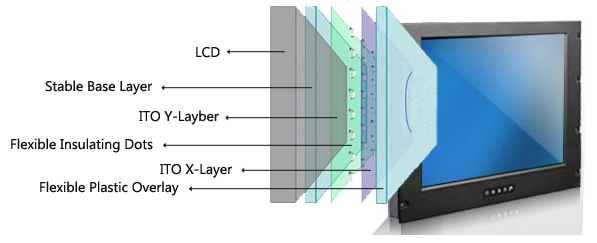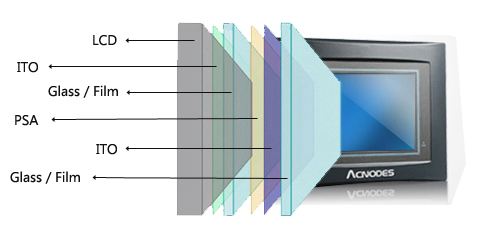Touch Screen Monitors - Overview
A touch screen acts as an interface between humans and computers in an automation control unit. Unlike keyboards or mice, touch screens provide convenience and user-friendly access to receive information from one computer to another. Another example would be a predefined user interface menu program which browses through the touch screen to gain system access to operate particle applications, like CNC controllers or ATM machines.
Touch screens work by detecting touch points according to physical relations. These are divided into three types:
1. Resistive type – Functions when a finger or other stylus produces voltage by way of the pressure sensors.
Most resistive touch screens surface is a layer of polyester film and a conductive metal coating. The bottom portion of the screen is attached to the liquid crystal display (LCD), and the top portion incorporates conductive painted glass plates. The glass plates are separated by tiny layers of polyester. These glass sheets are situated along the X-axis, Y-axis, and the polyester film, each with a controller, applying a small voltage in each gradient. Whenever pressure is applied to the screen, it puts the two conductive materials together, producing an electronic currency that can be detected by the X and Y coordinates.
Since the resistive screen requires two layers of material after the collision to react. Therefore, when the pressure of the screen becomes unbalanced, it results in touch errors. Moreover, the resistive screen can only rely on the two materials reacting to the collision, elastic material with lower utilization rates, shorter life expectancy.
2. Capacitive Type - Relays on the electrical properties of the human body to detect when and where on a display the user touches.
Capacitive touch screens have both sides coated with a conductive material and covered with scratch-resistant coating. Its glass is surrounded by electrodes that produce a low-pressure electric field outside and a conductive layer inside that provides electromagnetic shielding and noise reduction. Whenever the finger touches the screen, it will have a capacitive coupling with the conductive layer on the outer side of the electric field and absorbs small currents. Each electrode is responsible for measuring the current from all corners and then translates its coordinates to the controller.
It does not need to react on the lower collision and only transmits signals to the screen when the screen is touched. These touches are messages received to allow the calculation of its coordinates. Hence, capacitive screens can simultaneously support multiple points. The speed however depends on the number of points and the chip being used.
3. Acoustic or infrared - Uses Ultrasonic waves which pass over the panel.
Located at the four corners of the screen, it converts signals from the controllers ultrasonic glass. One side of the glass is a reflector and is responsible for generating a standing wave pattern. Once the finger touches the screen, it will absorb part of the standing wave. In this instance, the converter detects the relative attenuation of the controller and sets the coordinates.
Capacitive Screen and Resistive Screen Comparison
1. Touch sensitivity:
Resistive touch screen layers require pressure to make contact, you can use your fingers (even with gloves), nails, stylus, etc. to operate.
Capacitive touch can have subtle finger contact and can be charged from the bottom of the screen to activate the capacitive sensing system. Inanimate objects such as nails, gloves, etc., however, will have an invalid data input. Handwriting recognition is also difficult.
2. Precision:
Resistive touch screen’s accuracy of at least 1 single display pixel can be seen when using the stylus. Facilitates handwriting recognition and helps with small operation control.
It is said that capacitive touch screens utilize several pixels, which in effect limits the area of contact by way of the finger. So it is difficult to precisely target icons less than 1cm.
3. Multi-touch:
Resistive touch screen has no multi-touch capabilities
Capacitive touch screen implements the multi-touch via software. Most of the phone or tablet in today’s market supports multi-touch.
4. Transparency rate:
Resistive touch screen usually dedregates the picture quality of the screen. Sunlight reflection is also a problem.
Capacitive touch screen in this instance is suitable. No picture dedrigation and minimal sunlight reflection.
5. Cleaning:
Resistive touch screens are used with a stylus, fingers, or fingernails. The problem is that with these methods it is easy to leave fingerprints, grease, and bacteria on the screen. Making cleaning very troublesome.
Capacitive touch screen uses a whole finger touch as well, but its outer glass is easier to clean.
6. Surface resistance:
Resistive touch screen determines the fundamental characteristics of its coordinates by utilizing layers of polyester film. This film makes the screen very prone to scratches and frequent calibration. Its use of polyester layers though makes less vulnerable and less likely to break.
The capacitive touch screen uses the outer layer of the glass, making it somewhat indestructible. But, it is possible to break the glass in fragments. With this touch screen, stains or scratches are not as frequent.
Tips for identifying what touch screen you are using
Use your fingernails (not the skin) to gently press on the screen, if the screen has any reaction, it may be resistive or infrared screen. If this is the case, then gently press on the screen simultaneously with two fingernails on two different points respectively. If the cursor moves beneath any fingernail, this device uses the infrared technology but if the cursor moves between two fingernails, the screen is a resistive type touch screen. If this device did not respond to the nails, your next step would be to place two fingers on the screen. At this time, if the cursor moves beneath one finger, then the principle of that particular screen uses sound waves; if the cursor moves to the middle of the two fingers, it is then a capacitive touch screen.
To date, the Resistive type screens are the most widely used because of price and its availability. The capacitive screen must, on the other hand, is now a growing trend in the market. Its versatility and ease of use are contributing to it popularity. As for the acoustic version, this is still a new technology and will require more time before the consumer can accept and utilize it.
Touch Screens are widely used in today’s day to day living. Tourist kiosks, ATMs, point of sale terminals, industrial control systems, and phones are just some examples of things that utilize the touch screen function. To date, this market has now ballooned to about over a Billion U.S. dollars. Since this technology has been proven to be user friendly, durable, and cost-effective, the market has no limits.






